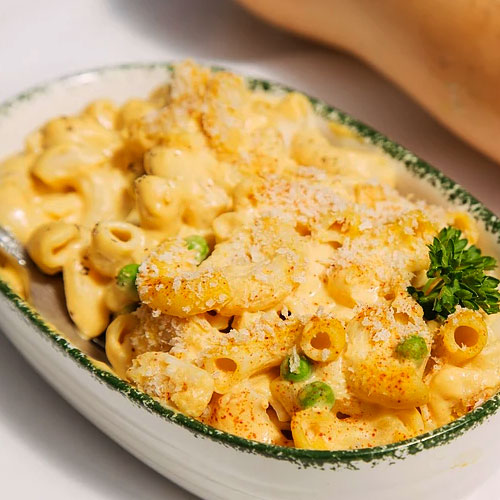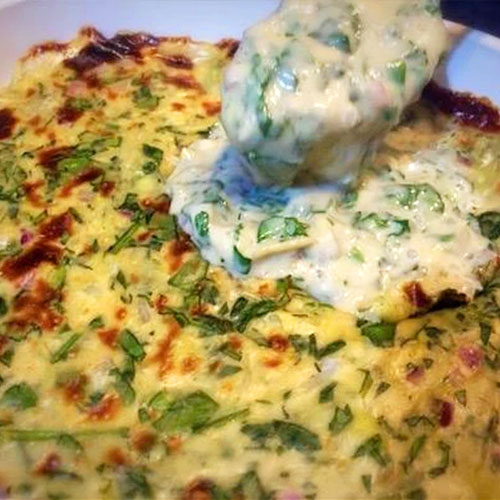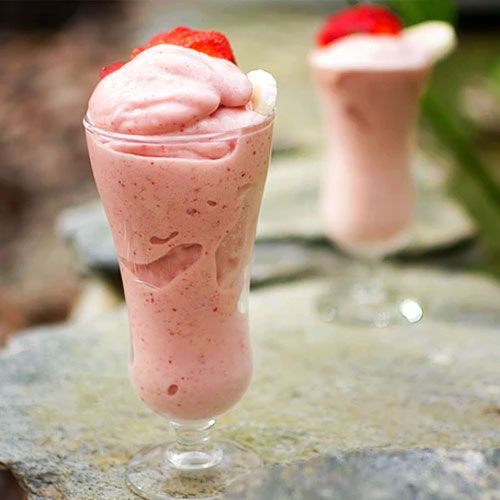Dairy is a primary cause of acne* — affecting 80-90% of all American adolescents.[1-2]
Acne is the most common skin disease in the U.S.[3] A growing body of epidemiological and experimental evidence confirms a strong connection between diet and acne.[4-9] While most adolescents and their parents understand that diet plays a role in acne, there is a lot of misinformation about which dietary factors are important. Many people are not aware of the connection with dairy.[10] And, because nutrition is generally not taught at medical schools, most doctors (and thus their patients) do not understand this connection.

Jeanette’s before and after photos**
“Children have no nutritional requirement for cow’s milk or dairy products. It is an unnecessary and harmful part of their diets.”
When humans ingest cow’s milk, we consume a ‘cocktail’ of hormones that are naturally present in cows milk, including IGF-1, insulin, estrogen and progesterone.[11] These hormones, which cannot be avoided by drinking ‘organic’ or ‘grass fed’ milk, stimulate the overproduction of our own hormones, triggering processes[12-20] that ultimately cause the human body to produce an oily substance called sebum, which can cause or exacerbate acne.[21-23] In addition, cow’s milk contains high levels of the wrong kind of protein that also turns on our own signaling pathways, further contributing to the development of acne.[24-25]
“Removing dairy is the first and most important dietary change you should make to prevent and treat acne.”
If you or a loved one is suffering from acne, there is hope! Many people can help heal their skin by consuming a whole food, plant-based (WFPB) diet that is dairy-free, naturally low in fat and inflammatory foods and containing the right kind of protein and a generous supply of phytochemicals. And dairy isn’t just bad for your skin. It is also implicated in dozens of other disease processes including asthma, eczema, allergic rhinitis, recurrent ear and sinus infections, constipation, cardiovascular disease and some cancers. Removing dairy from your diet will benefit your whole body!
The issues surrounding dairy consumption can be personally, culturally and politically sensitive. We have been told for years by the dairy industry and food policy makers that milk ‘does a body good’. For many families, it is a central part of their kids’ diets and parents truly believe it is a healthy choice. But scientific evidence tells a different story. Cow’s milk isn’t meant for humans, but for rapidly growing calves. Humans are provided our own milk during infancy. Bottom Line: Dairy isn’t good for our skin, and it isn’t good for our bodies. So, ditch the dairy for clearer skin and improved overall health!
5 TIPS FOR DITCHING DAIRY TODAY
JOIN OR START A LOCAL WFPB GROUP for support getting started on your whole food, plant-based (WFPB) journey. Becoming part of the PlantPure Communities Pod Network opens the door to encouragement, education, and networking opportunities.
START TRANSITIONING TO WFPB with the help of this Toolkit! For example, the info sheet WFPB Grocery Basics lists common ingredients found in WFPB recipes – most of which can be purchased at chain grocery stores.
WATCH A FILM: There are dozens of films available about food and health – such as the PlantPure Nation film – many of which are available for free on Netflix or YouTube.
READ A BOOK: Learn more about a WFPB lifestyle (everything from nutrition science to casseroles) from one of these books – including The Clear Skin Diet: The Six-Week Program For Beautiful Skin. (**Results achieved using dairy-free Clear Skin Diet program.)
GET COOKING: Try these delicious (and skin-friendly) plant-based renditions of your favorite foods:
Macaroni and No Cheese
This is a great kid-friendly recipe. The cheese sauce is butternut squash and cashew-based, which gives it a slightly sweet flavor. Peas are typically used in this dish but you can also add broccoli, onions, spinach, or even a few mushrooms.
Spinach Artichoke Dip
This cheesy dip makes the perfect party dish! You can use it for toasted cheese sandwich filling or as a topping for baked potatoes or pasta with grilled veggies. The combinations are never ending!
Berry Banana Ice Cream
There is no need to go without an occasional ice cream treat because frozen bananas are the perfect base for a plant based frozen treat. Because bananas are naturally sweet, there is no need to add any sugars. If you’re trying to impress a dinner guest, make this recipe and top it with coconut flakes and chocolate shavings.
Baked Potato Soup with Sour Cream
This creamy soup is loaded with the flavors of a real baked potato topped with plant-based sour cream and smoked paprika.
*In writing this article, PlantPure Communities (PPC) consulted with T. Colin Campbell, PhD, co-author of the NYTimes bestselling book, The China Study, who serves on PPC’s Advisory Board. Dr. Campbell is the Jacob Gould Schurman Professor Emeritus of Nutritional Biochemistry at Cornell University, and a bio/nutritional researcher with over 60 years of experience in the field of nutritional science.
Dr. Campbell, who grew up on a dairy farm, explains that while a specific association of dairy with teenage acne has been acknowledged by many people, with considerable amount of supporting anecdotal evidence, there is a need for more rigorous studies to better understand the size and specificity of this effect. Teenage acne is the 8th most common disease worldwide, although this is mostly concentrated in dairy consuming countries, where 10-20% of teenagers suffer moderate to severe acne. Recent research studies, however limited they may be, convincingly suggest that the association of dairy with teenage acne is not only a relatively common problem, but that there is no redeeming value in advocating for increased dairy consumption among young people. This practice is even more questionable when follow-up use of dairy products, along with other animal protein-based foods, substantially increases risk for other degenerative diseases later in life. Indeed, it has now been convincingly shown that diets high in animal protein-based foods associate with and cause a broad spectrum of serious diseases. The dairy-acne association is consistent with this broader linkage. Recognizing the ongoing issue of misinformation about nutrition, Dr. Campbell feels it is important to also share information about his history.
- 80-90% of American adolescents experience some form of acne (mild, moderate or severe). Acne occurs when sebaceous (oil) glands in our skin become obstructed and inflamed. https://onlinelibrary.wiley.com/doi/full/10.1111/j.1365-4632.2009.04002.x
- https://jandonline.org/article/S0002-8223(09)01867-7/fulltext
- https://www.merckmanuals.com/professional/dermatologic-disorders/acne-and-related-disorders/acne-vulgaris
- https://onlinelibrary.wiley.com/doi/full/10.1111/j.1365-4632.2009.04002.x
- Cordain L, Lindeberg S, Hurtado M, et al . Acne vulgaris: a disease of Western civilization. Arch Dermatol 2002; 138: 1584–1590.
- Steiner PE. Necropsies on Okinawans. Arch Pathol 1946; 42: 359–380 .
- A 2005 study involving more than 47,000 nurses revealed that milk products (whole, powdered, low‐fat, and skimmed) were all associated with self-reported acne in teenage girls, and total milk and skim milk intake was associated with acne formation in teenage boys. Adebamowo CA, Spiegelman D, Danby FW, et al . High school dietary intake and teenage acne. J Am Acad Dermatol 2005; 52: 207–211.
- Adebamowo C, Spiegelman D, Berkey CS, et al . Milk consumption and acne in teenaged boys. J Am Acad Dermatol 2008; 58: 787–793.
- Adebamowo C, Spiegelman D, Berkey CS, et al . Milk consumption and acne in adolescent girls. Dermatol Online J 2006; 12: 1–13.
- https://jandonline.org/article/S0002-8223(09)01867-7/fulltext
- Milk and whey protein-based products contribute to acne due to their influence on insulin and insulin like growth factor (IGF-1). Together, these hormones sensitize and stimulate androgen receptors in the body AND provide the receptors with dairy-derived androgens (estrogen and progesterone), leading to the processes that stimulate acne formation. https://www.ncbi.nlm.nih.gov/pubmed/21335995
- https://www.ncbi.nlm.nih.gov/pubmed/21335995
- Cow’s milk contains the hormones estrogen and progesterone along with certain hormone precursors, some of which have been implicated in the development of acne. These hormones are androgen precursors lead to increased androgen levels in the body, triggering the acne formation process. https://www.ncbi.nlm.nih.gov/pmc/articles/PMC3481796/
- Melnik B. [Acne vulgaris. Role of diet] Hautarzt. 2010;61:115–25.
- Melnik BC, Schmitz G. Role of insulin, insulin-like growth factor-1, hyperglycaemic food and milk consumption in the pathogenesis of acne vulgaris. Exp Dermatol. 2009;18:833–41.
- Melnik BC. The role of transcription factor FoxO1 in the pathogenesis of acne vulgaris and the mode of isotretinoin action. G Ital Dermatol Venereol. 2010;145:559–72.
- Melnik BC. Acneigenic Stimuli Converge in Phosphoinositol-3 Kinase / Akt / FoxO1 Signal Transduction. J Clin Exp Dermatol. 2010;1(101):1–8.
- Melnik BC. FoxO1 – the key for the pathogenesis and therapy of acne? J Dtsch Dermatol Ges. 2010;8:105–14.
- https://www.ncbi.nlm.nih.gov/pubmed/21034984/
- A bacteria called Propionibacterium acnes (P. acnes) lives in the oily regions of our skin’s pores. Hormones (androgens) can stimulate the oversecretion of oily matter (sebum), which when combined with bacteria and dead skin cells, creates an inflamed and red pore, also known as a zit. https://www.viva.org.uk/white-lies-part-two-dairy-consumption-and-health/acne
- https://www.ncbi.nlm.nih.gov/pmc/articles/PMC3481796/
- According to Dr. Jerome Fisher (dermatologist), ‘About 80 percent of cows that are giving milk are pregnant and are throwing off hormones continuously.’ Progesterone breaks down into androgens, which have been implicated as a factor in the development of acne…Dr. Fisher observed that his teenage acne patients improved as soon as the milk drinking stopped. http://www.notmilk.com/z.html
- https://www.merckmanuals.com/professional/dermatologic-disorders/acne-and-related-disorders/acne-vulgaris
- Melnik BC. Dietary intervention in acne. Attenuation of increased mTORC1 signaling promoted by Western diet. Dermatoendocrinol. 2012;4:20–32. doi: 10.4161/derm.19828
- Melnik BC, Zouboulis CC. Potential role of FoxO1 and mTORC1 in the pathogenesis of Western diet-induced acne. Exp Dermatol. 2013;22:311–315. doi: 10.1111/exd.12142







